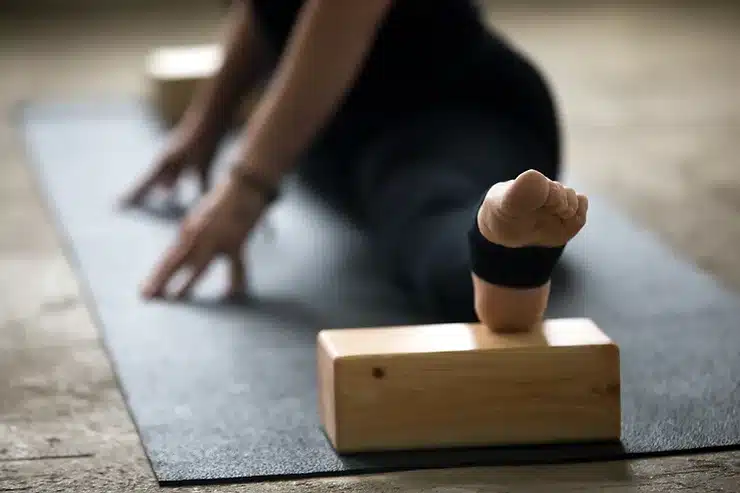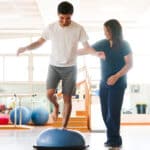How you return to exercising really depends on the injury you’ve suffered—where the injury is located and how severe it is. Your existing level of health will also impact your recovery time and the rehabilitation progress you’ll make.
Below are some of the types of injury recovery exercises for specific types of injuries and what to expect as you return to exercise after your injury. These are exercises you can repeat multiple times daily to promote strength and rehabilitation.
It’s encouraged to review all rehabilitation and recovery exercises with a professional trainer or physician before diving in. Getting expert advice will ensure you’re not doing too much too soon.
1. Back Injury Recovery
Properly recovering from a back injury is critical to your spinal health. It ensures you maintain your mobility, posture, and muscle strength so you can protect your spine. The key to recovering from a back injury is your core.
After having suffered a back injury, it’s important to focus on strengthening your core—a powerhouse muscle group consisting of over 30 muscles in your abdomen and low back. Having a strong core will reduce the risk of developing chronic pain from your injury and will mitigate the chance of reinjuring your back.
If you’re returning to exercise after an injury to your back, try these core strengthening moves:
-
Pelvic Tilts: Lie with your back flat on the floor, knees bent. Place your hands on your hip bones and slowly tilt your pelvis toward and then away from your rib cage. You’ll feel your low back lift. Continue this movement for one minute.
Bird Dogs: Begin on hands and knees with a tight core. Slowly extend one arm straight forward and the opposite leg straight behind, holding for 3-5 seconds. Bring your arm and leg back to the center and switch sides. Repeat 6 times per side.
2. Shoulder Injury
Shoulder injuries such as bursitis or tendonitis can be chronic and take a long time to heal. They can cause severe pain and impact your quality of life, making it difficult to perform movements such as reaching, pulling, or pushing.
Because shoulder injuries often occur due to overuse, such as from repetitive motions, it’s difficult to perform shoulder injury rehab right away. Your shoulder needs time to rest so it can actually get stronger before you start exercising again.
Once you’ve been cleared to begin using it again, shoulder injury rehab is the next step. You can rehabilitate and strengthen your shoulder muscle with the following exercises:
-
Pendulum: In a standing position bend forward at the waist and support yourself on a counter or chair with one arm. Let your injured arm hang down. Gently swing your arm back and forth, side to side, then in circles. Repeat on the other side. Perform this exercise 3 times daily.
-
Crossover Arm Stretch: Stand with shoulders straight and relaxed. Gently pull one arm straight across your chest. Hold the stretch for 30 seconds and repeat on the other side.
3. Hamstring Injury
Hamstring strains can be incredibly painful and debilitating. Like shoulder injuries, if a hamstring injury isn’t properly rehabilitated, it can become a chronic or recurring problem. To properly rehabilitate your hamstring, it’s important to find ways way to continue to use it without straining it even more.
You can perform isometric hamstring exercises which flex the muscles without stretching them. Additionally, as part of hamstring injury rehab, you’ll want to strengthen your glutes. Because your hamstrings and glutes work together, having strong glute muscles can prevent future hamstring injuries.
To start your rehabilitation, try these two hamstring exercises after injury:
-
Single-Leg Bridge: Lie on the ground, back flat and knees bent. Activate your glute muscles and raise one leg up. Keeping your leg raised, push into your heel, and raise your hips off the floor. Keep your shoulders flat to the ground, and your core, glutes and hamstring engaged. Repeat 10 times on each side.
-
Hamstring Curl: Lie on your front with your legs straight. Place a pillow under your stomach if it’s more comfortable. Slowly bend the knee of your affected leg toward your buttock, stopping when you feel resistance. Continue this motion 8-12 times per side.
4. Groin Injury
Groin injuries can be caused by pulled or strained groin muscles (adductors). These injuries typically affect athletes and can recur if not properly treated.
After resting and icing a groin injury, you may decide to return to physical activity with some groin injury rehab exercises:
-
Adductor Squeeze: Lie down with your back flat on the ground. Raise bent legs so your shins are parallel with the floor. Place a soccer ball between your knees and squeeze them together until you feel your groin muscles activate. Hold the squeeze for 2 seconds. Release and repeat 10 times.
-
Side-Lying Leg Lift With Crossover: Lie down on the side of your injury. Bend your top leg and place your foot flat on the ground in front on your bottom leg. Keeping your bottom leg straight, slowly raise it up as far as it will go. Hold for 5 seconds and repeat 15 times. Switch sides and repeat for 2 sets.
5. Knee Injury
Knee injuries are very common as it’s one of the most used joints in the body—and the most susceptible to wear and tear. Initially, following a knee injury, you’ll want to work on getting your range of motion back, and it’s advisable to work with a physiotherapist for this.
Chronic knee injuries can be rehabilitated by strengthening the muscles around the knee joint, which provide stability and mobility. Additionally, having strong hips takes the pressure off the knee so it can continue to function properly.
To help rehabilitate, try the following knee strengthening exercises after injury:
-
Straight Leg Raises: Lie with your back flat on the ground, one knee bent and foot flat to the floor. Extend your other leg long and raise it slowly up to the height of your bent knee. Repeat 15 times per leg, 3 times daily.
Step-Ups: Standing on the bottom stair of a staircase, bend one knee and lightly touch the other foot to the floor behind you. Raise it back up. Repeat 15 times then switch legs. You can increase the height of the step-up as your knee feels stronger.





